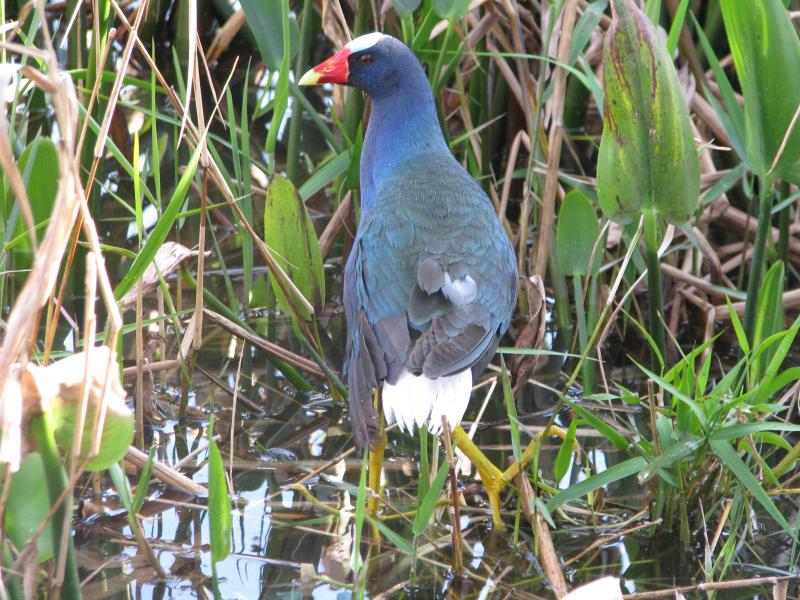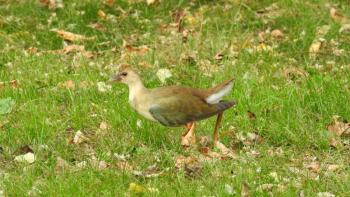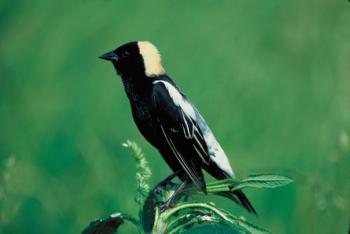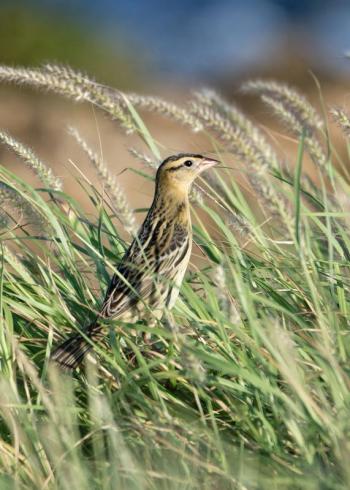Imagine the ultimate Halloween costume. A disguise so incredibly integrated with you that it transforms your appearance completely and wears as easy as your most comfortable clothes. Now imagine this costume just appearing automatically, without any special trips to Halloween stores or hours of tinkering with accessories.
A fantasy, you say?
These “disguises” only exist, but you may have actually seen them! Many birds have been the ultimate masters of exactly this kind of Halloween disguise for millions of years.
We started thinking about this when we learned of the discovery of not one, but two, purple gallinules in recent weeks here in Maine. As its name suggests, the purple gallinule is a stunning bird, all bluish-purple with bright yellow legs and orange-red bill. But that’s not the whole truth.
Immature purple gallinules have none of this stunning coloration and instead wear muted tans and drab greens. That’s not to say they aren’t beautiful in their own way as well. What they are not, however, is generally as eye-catching to us humans—and, presumably, to hungry predators that would like nothing more than a chicken-sized gallinule for dinner.
Purple gallinules are birds of warmer climes, making it regularly only as far north as coastal South Carolina. Like many birders, we often have enjoyed seeing them in Florida. On occasion, a few birds will head north in the fall or even in winter—there are a number of records of one of these long-toed birds suddenly appearing here in Maine, clambering rather forlornly over snow banks and frozen roadsides. Why this happens is still more than a little unclear but it would appear to be that dispersing young birds are caught up in southern winds and get carried far beyond the climes that they can easily survive in.
Here in Maine, there have been two purple gallinules found this October: one near Greenville, and another in Kennebunk. This is part of a wider movement of the specie this October. Two have been found in Quebec, one in Ontario, one in Nova Scotia (the only adult, with the gawdy plumage, among them), one in Massachusetts, and two in New York.
Many other species follow the purple gallinule mode of dressing in a demure costume while in the immature stage. Birds like indigo buntings, scarlet tanagers, American goldfinches, and northern cardinals are among the many species in which the immature birds sport a less colorful and better camouflaged plumage than the adults, especially drabber than the breeding-plumaged males.
A whole set of other birds change their costume every year, even after attaining adulthood. For many of these species, Halloween time is when they have switched over to their new, and likely safer, costume. One of our favorites that make an extreme plumage costume switch is the male bobolink. Bobolinks spend the winter in the grasslands of Argentina, Paraguay, and Brazil, and make the long journey north to breed in grasslands across the northern half of the U.S. and southern Canada. The males are exuberant, loud singers that glide over hayfields and prairies, showing off black bodies with contrasting golden napes and bold white patches on the rump and wings.
Come late July and August, though, the males seem to disappear. That’s because they stop singing, molt into a brownish, sparrow-like plumage (similar to the females and immatures), and become just another look-alike member of the bobolink flocks that will soon begin their perilous trek south.
We hope your Halloween costume was as successful at disguising your identity as the costume changes of some pretty cool birds.
Jeffrey V. Wells, Ph.D., is a Fellow of the Cornell Lab of Ornithology and Vice President of Boreal Conservation for National Audubon. Dr. Wells is one of the nation's leading bird experts and conservation biologists. He is a coauthor of the seminal “Birds of Maine” book and author of the “Birder’s Conservation Handbook.” His grandfather, the late John Chase, was a columnist for the Boothbay Register for many years. Allison Childs Wells, formerly of the Cornell Lab of Ornithology, is a senior director at the Natural Resources Council of Maine, a nonprofit membership organization working statewide to protect the nature of Maine. Both are widely published natural history writers and are the authors of the popular books, “Maine’s Favorite Birds” (Tilbury House) and “Birds of Aruba, Bonaire, and Curaçao: A Site and Field Guide,” (Cornell University Press).































